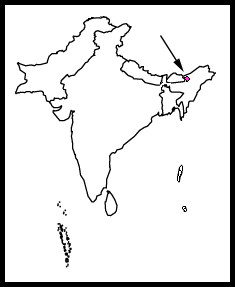- Liocichla bugunorum
Identification
A colourful Liocichla from India, described oficially in 2006, discovered in 1995 by the Indian birdwatcher Ramana Athreya. As there have not been many sightings yet there is little information about feeding, breeding and other aspects of the biology of this species.
- Greyish-olive plumage with black crown
- Yellow lores and broken supercilium
- Broad yellow wing patches
- Red tips on undertail coverts and tail
The female seems to be similar but duller.
Distribution
| Endemic to India. Only known from a small area around Lama Camp in western Arunachal Pradesh in north-eastern India. Another site was discovered in 2011 about 100kms away at Bomdila (2700m). 2 birds were recorded there. | |
| Legend • L. bugunorum; year-round |
Taxonomy
Forms maybe a superspecies with Emei Shan Liocichla and Steere's Liocichla, but further study needed.
This is a monotypic species[2].
Habitat
Found in heavily disturbed hillsides and ravines, covered with dense shrubbery and small and medium-sized trees (left after logging). One sighting at edge of primary forest. All records are between 2060 and 2340m.
Behaviour
Diet
Has been seen to take berries, foraging on ground. Also observed in all levels of vegetation, up to the canopy. Usually in pairs, outside the (presumed) breeding period in small flocks. Sometimes together with other birds as Himalayan Cutia, Chestnut-crowned Laughingthrush or Blue-winged Laughingthrush.
Breeding
Breeding period probably in May when pairs have mated and are reacting territorally. No information about nest, clutch size or anything else.
Movements
Presumed to be resident.
References
- Del Hoyo, J, A Elliott, and D Christie, eds. 2007. Handbook of the Birds of the World. Volume 12: Picathartes to Tits and Chickadees. Barcelona: Lynx Edicions. ISBN 978-8496553422
- Clements, J. F., T. S. Schulenberg, M. J. Iliff, S. M. Billerman, T. A. Fredericks, B. L. Sullivan, and C. L. Wood. 2019. The eBird/Clements Checklist of Birds of the World: v2019. Downloaded from http://www.birds.cornell.edu/clementschecklist/download/
Recommended Citation
- BirdForum Opus contributors. (2024) Bugun Liocichla. In: BirdForum, the forum for wild birds and birding. Retrieved 25 April 2024 from https://www.birdforum.net/opus/Bugun_Liocichla





